Block A (Adel, Katie and Alexis)
Presentation: Angiosperm
Review Sheet: Angiosperm Review Sheet
Block C (Michelle, Josie, Sydney, Aliyah, Kanta, Narmin, Megan)
Presentation: Angiosperm Presentation
Game: Jeopardy
Review Sheet: Angiosperm Review Sheet
Worksheet (and answers): Angiosperm Worksheet Angiosperm Worksheet Answers
Angiosperm (Summary)
(Adapted from Miller and Levine, 473) As the “flowering plants”, all angiosperms reproduce sexually through their flowers. Unlike the gymnosperms, the seeds of angiosperms are not “naked”, but carried in a protective wall (ovary) that will later develop into the fruit.
Structure and Function
Flowers have many of the adaptations that make it well suited for life on dry land, including:
- Cuticle
- Vascular tissue
- Seed coat
- Pollen grain
- Fruits and Flowers
The adaptation that makes angiosperms unique from all other plant groups we have discussed so far is the flower, the part responsible for sexual reproduction. Some angiosperms have male and female parts on separate flowers, while some angiosperms have both male and female parts on the same flower.
 The Stamen is the male reproductive organ of the flower. It includes the
The Stamen is the male reproductive organ of the flower. It includes the
- Anther: contains the microsporangia (microspore mother cells) where microspores are produced.
- Filament: long thin stalk that holds up the anther
The Carpel is the female reproductive organ of the flower. It includes the
- Stigma: the sticky part where pollen grain attaches
- Style: holds up the stigma
- Ovary: holds the ovule(s). Will eventually develop into the fruit.
The ovules is the site of double fertilization, a process unique to angiosperms. It will eventually develop into the seed.
Examples


Angiosperms make up the grand majority of plants in the world today. Whereas during the time of the dinosaurs, conifers were the dominant group, angiosperms rule the world today. Here are just several examples of all the angiosperms we have:
- All fruit trees
- Grasses
- Berries
- Deciduous trees
- Tulips, roses, etc.
- Rice, corn and grains
Reproductive Cycle
The beautiful diagram to the left (courtesy of Team Angiosperm block C), includes more detail than you are required to know. Nevertheless, it is an informative diagram that should help you in understanding the angiosperm life cycle.
Steps in the Reproductive Cycle
- The Sporophyte generation is represented by the plant itself, and the flower. The flower contains the anther and ovule(s).
- The anther contains many diploid microspore mother cells, which will then divide via meiosis to create microspores, which become the pollen grains. The pollen grains will then develop into sperm when it reaches the ovule.
- Microspore mother cell (2N) —> Microspores (N) —> Pollen grains (N) —> Sperm (N)
- Each ovule (contained within the ovary) contains one megaspore mother cell (2N), which will then divide via meiosis to produce a total of eight haploid cells. These eight haploid cells and the membrane that surrounds it is the embryo sac. Five of the haploid cells will disappear, two of them will become the polar nuclei, and one will become the egg cell.
- Megaspore mother cell (2N) –> Embryo sac (8 haploid cells + membrane) –> Polar nuclei (2N) and egg (N)
(Fertilization) Both the polar nuclei and egg will be fertilized by the sperm- The polar nuclei will become a triploid structure (3N) called the endosperm, it provides the nutrition for the developing embryo
- The egg and sperm will become a diploid structure (2N) called the zygote, which will develop into the embryo.
















%20square.jpg)




















